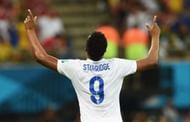The Three Lions are probably the most unpredictable outfit to ever play competitive football. Penalty shootouts losses, spice boys, petulant red cards, tears of joy and tears of agony, England fans have been through it all. There’s only been one constant, from Bobby Moore’s World Cup winners to the Golden generation of the early 2000s, a new crop of heroes will rise to wear the famous strip.
How that squad won nothing is a mystery for the ages. But whatever the case, there was always quality on show with some magic moments like Beckham vs Greece and Owen vs Argentina. And today is no different with a young squad packed with talent and ready to take on the world.
Hang on a minute! It’s 2016. The Golden Generation probably came to an end in 2008. What happened in between?
An aging squad struggled to cope with no new stars emerging to take their place. So much so that Emile Heskey and Matthew Upson played against Germany in the 2010 World Cup. No offence to the pair but if you can score 6 league goals for Aston Villa and play for England, something is seriously wrong.
One entire generation of players went missing primarily on the treatment table.
The goalkeeper and defence
At the start of the new millennium, Dave Seaman’s career as undisputed England #1 was drawing to the close and it was widely regarded that Chris Kirkland would replace him in goal. After coming good at Coventry he secured a transfer to Liverpool where he was brought in as competition to Jerzy Dudek and many felt it was just a matter of time before he displaced him from the starting eleven.
Initially, the signs were looking good and by the start of the 2004-05 season he had ousted the veteran from in between the sticks. But a horrifying back injury saw him miss the entire latter half of the season as his team, with Dudek in goal, went all the way to the Champions League glory in Istanbul.
He never made it back into the team and at one point in 2006, it was even rumoured that he would have to retire. But he soldiered on and managed to secure a move to Wigan but his back issues would return once again and Kirkland would never again wear the famous Three Lions strip.
With the Sol Campbell, John Terry and Rio Ferdinand reaching the twilight of their careers and the retirement of Gary Neville and Jamie Carragher, it was hoped that Michael Dawson, Ledley King and Jonathan Woodgate would step up. Labelled “an absolute freak” by Harry Redknapp, King was a Spurs boy through and through, even rejecting interest from Chelsea in the mid-2000s.
But he was plagued by chronic knee problems, and never clocked the 30-appearance mark in any season since. He had a great career and will always remain a Spurs legend but it could have been so much more.
Ask any Englishman about sporting disappointments and be ready to hear about Steve Harmison and Jonathan Woodgate. Woodgate started his career at Leeds United before securing a transfer to Premier League giants Newcastle. And like Santiago Munez from Goal, his success for the Toons saw him secure a big money move to join the Galacticos of Real Madrid.
Also read: Ledley King - Best of his generation
It was hoped that he would emulate the successes of fellow English stars, Steve McManaman and David Beckham. But a serious injury suffered while still at Newcastle resulted in him missing the entirety of his first season in the Spanish capital. He never really settled down there and after just 14 appearances, his Spanish nightmare ended with a transfer to Middlesborough. A move to Spurs was hampered again by more injury problems he was released in June 2011.
A total of 8 national caps was a complete travesty to a truly special talent. In recent times both Kieran Gibbs and Phil Jones have faced roadblocks spending lengthy layoffs on the treatment table.
The midfield
It all began with Owen Hargreaves. Already a Champions League winner, the future looked bright for Hargreaves when he secured a £17 million move back to England with Manchester United. A double followed and it seemed England had found their next midfield lynchpin.
Then disaster struck. A recurring tendonitis problem resulted in him needing surgery in both knees and he missed an entire season as a result. He was never the same again. Less than 5 appearances in the next 4 years and even a transfer to arch rivals Manchester City could not resurrect his career. This left a gaping hole in the heart of the English midfield.
Once injuries claimed Hargreaves’ career the eyes of the nation turned to two young central midfielders Jack Wilshere and Fabian Delph. After rising up through the ranks at Leeds, Delph, the older of the two, secured a move to Aston Villa where he just cracked the first team before a cruciate ligament injury cost him 8 months.
This was just after the 2010 World Cup, at a time when England were looking to their youth to rejuvenate the national team. His confidence had to be rebuilt from scratch and it would be 4 more years in 2014 before he made his international debut. Meanwhile, Wilshere burst onto the scene with Arsenal and received his first call up at the tender age of 18.
Touted as the solution to of England’s woes and earmarked as a future captain, he made over 50 appearances for club and country in the 2010-11 season. This was too much for the young lad who suffered a stress fracture and lost the better part of the next two years.
If that wasn’t enough he even missed the entirety of the 2015-16 season because of a broken fibula. While time may still be on the side of both these men, they should really have cemented their slots in the England team by now. The curse strikes again.
The attack
It could have been so different for Theo Walcott. Selected rather bewilderingly in 2006, dropped even more surprisingly in 2010, and out injured in 2014, its comes as a shock to many how Theo Walcott has still not represented England at a World Cup. Having represented England at the U16, U17, U19 and U21 levels, a senior team breakthrough always seemed imminent.
But his pace and excellent movement coupled with a light build have made him a target for defenders since he hit the big the big time. He was seen as the next big thing and Beckham’s successor in the right wing. But repeated injuries have hampered his progress and just when he seemed ready, a ruptured cruciate ligament saw him ruled out of the 2014 World Cup.
Now 27 and left out of the squad for the Euros, you wonder if an England career is beyond him now.
When Michael Owen was phased out of the team in 2008, the striker’s role alongside Wayne Rooney was up for grabs. Peter Crouch, Darren Bent and Jermain Defoe were all given their chance but did not catch the eye. After meandering his way through Manchester City and Chelsea, Daniel Sturridge finally got his big break at Liverpool. 21 goals in the 2013-14 season and it seemed like England had their next number 9.
But over the next two years, injuries to his hip, hamstring, thigh and quadricep have seen him spend more than his fair share of time on the treatment table. In fact, he has spent more than 500 days out injured since joining Liverpool in 2013. What’s especially frustrating is that when he is out on that pitch his quality is undeniable, be it for club or country. But with Sturridge, it’s become a case of so near yet so far.
You begin to wonder if it’s a reaction to the physical style of English league football or something else altogether but it’s happened too often for it to be attributed to random chance.
All that potential unfulfilled and the Three Lions fans left wanting. But they’ll be hoping this new crop of players can stay away from the injury hoodoo and give some success to a nation on the golden anniversary of their last trophy on the international stage.


